Silvia Giordani, born in 1992, is a Venetian artist whose work delves into the realms of dream, space, and time. Giordani's recent presence in the coastal town of Knokke, June 2024 served as a catalyst for her exploration of a dreamy, surreal landscape, where clouds rise like monoliths into the sky. This setting aligns seamlessly with her exhibition "Moon Walk," curated by Domenico de Chirico, further emphasizing her engagement with ethereal and otherworldly themes.
Giordani's oeuvre reflects a deep engagement with contemporary art, characterized by her innovative exploration of landscapes that transcend conventional temporal and spatial boundaries. Her work is a testament to her ability to weave together historical references with a modern sensibility, creating pieces that resonate with both past and future.
In addition to her Surrealist influences, Giordani's work is imbued with elements from other artistic movements and cultural references. For instance, the enigmatic quality of her landscapes can be compared to the metaphysical works of Giorgio de Chirico, another Italian master who explored dreamlike, almost theatrical settings. Moreover, the minimalist yet profound visual language of Agnes Martin, with her subtle gradations and quiet intensity, can be seen as an inspiration that adds depth to Giordani's canvases.
Through her detailed depiction of monolithic clouds and surreal terrains, Giordani invites viewers into a meditative space where the lines between reality and imagination blur. Her paintings often evoke a sense of timelessness, capturing moments that seem to exist both in ancient times and distant futures. This duality is a hallmark of her artistic exploration, offering a contemplative view of the world that challenges perceptions and evokes deep emotional responses.
In a recent interview, Giordani shared insights into her creative process, revealing how her surroundings and experiences inform her art. Her presence in Knokke, with its unique landscape and atmospheric conditions, provided a rich source of inspiration. The way she translates these experiences into her work, merging them with her thematic preoccupations of dreams and surrealism, underscores her role as a visionary artist in the contemporary art scene.
By integrating a wide array of influences and continually pushing the boundaries of visual expression, Silvia Giordani stands out as a pivotal figure in modern art. Her ability to draw from the past while envisioning the future makes her work a compelling exploration of the human condition and the mysteries of existence.
A Venetian Foundation
Based in Venice, Giordani thrives in a shared studio with ten other painters, fostering a collaborative and inspiring environment. Her academic background from the Academy of Fine Arts in Venice, coupled with her experiences working with prominent figures like Mauro Zocchetta, Mirella Brugnerotto, and Cristina Treppo, has profoundly influenced her artistic development.
Giordani's daily life in Venice plays a crucial role in her creative process. She describes her routine as one that finds inspiration in the mundane, transforming everyday observations into profound artistic expressions. Whether it is the serene canals, the historic architecture, or the vibrant local art scene, every aspect of Venice enriches her artistic vision. Walking through the city, Giordani often pauses to observe the play of light and shadow on the water, the texture of ancient stone buildings, or the transient beauty of cloud formations-elements that frequently find their way into her paintings.
![Marina di Ravenna, 1986, Luigi Ghirri (Photograph) Arrigo Ghi (Stampatore), Esposizione: Vista con camera : 200 fotografie in Emilia Romagna (Esposizione), [1986], 1986, Ghirri, Luigi. Marina di Ravenna, 1986 / Luigi Ghirri. - [1986] (Modena: Arrigo Ghi, 1992). - 1 fotografia : positivo a colori cromogenico ; 334x470 mm. - (Esposizione: Vista con camera : 200 fotografie in Emilia Romagna), Signature: 94707.](https://artlogic-res.cloudinary.com/c_limit,f_auto,fl_lossy,q_auto/ws-artlogicwebsite1878/usr/library/main/images/marina-di-ravenna-1986-luigi-ghirri-fotografo-arrigo-ghi-stampatore-esposizione-vista-con-camera.png)
Marina di Ravenna, 1986, Luigi Ghirri (Photograph)
Arrigo Ghi (Stampatore), Esposizione: Vista con camera : 200 fotografie in Emilia Romagna (Esposizione), [1986], 1986, Ghirri, Luigi. Marina di Ravenna, 1986 / Luigi Ghirri. - [1986] (Modena: Arrigo Ghi, 1992). - 1 fotografia : positivo a colori cromogenico ; 334x470 mm. - (Esposizione: Vista con camera : 200 fotografie in Emilia Romagna), Signature: 94707.
Her influences are not limited to the grandiose but extend to the minutiae of daily life. Giordani finds beauty in the simplest of moments, such as the geometry of vegetables being cut or the rhythmic patterns of everyday tasks. This attentiveness to detail echoes the photographic works of Luigi Ghirri, whose ability to find extraordinary beauty in the ordinary is a clear inspiration for Giordani. She draws from Ghirri's philosophy, seeing the world with "other eyes," where even a shower in Knokke can become a surreal focal point, blending seamlessly into her dreamy landscapes.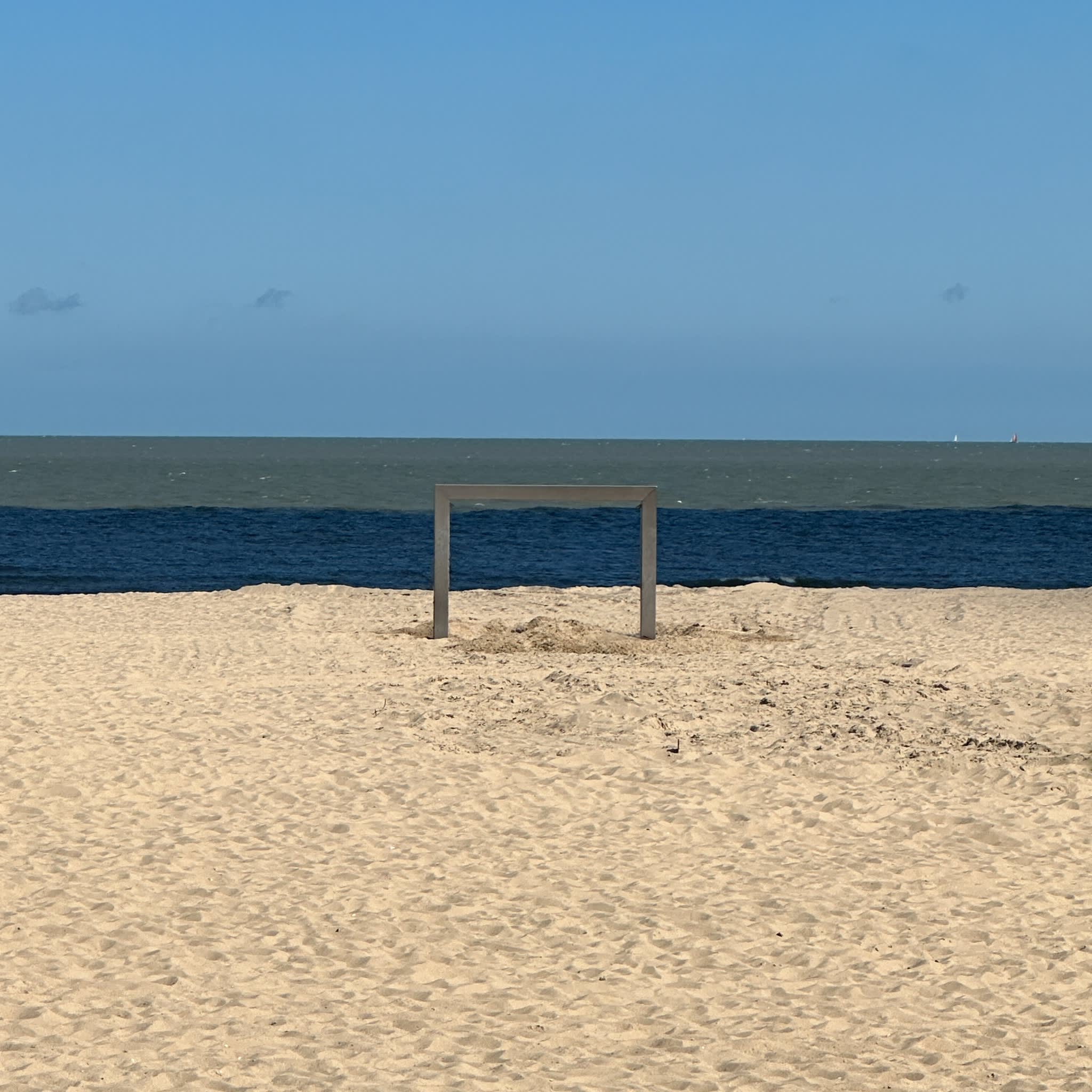
Minimal Shower
Knokke-Heist, July 2024, picture courtesy of Buysse Gallery
The collaborative nature of her studio environment also fuels her creativity. Interacting with fellow artists allows for a continuous exchange of ideas and techniques, fostering an atmosphere of mutual growth and innovation. This synergy is evident in her work, which often incorporates diverse elements and experimental approaches inspired by her peers.
Incorporating these daily influences, Giordani's artistic process is both intuitive and meticulous. She begins with spontaneous sketches, allowing her subconscious to guide the initial strokes, before refining and layering her work to achieve the desired depth and complexity. This method mirrors the surrealist technique of automatism, championed by artists like Max Ernst, further embedding her work within a rich art historical context.
By intertwining her Venetian surroundings with broader surrealist influences, Silvia Giordani creates art that is both deeply personal and universally resonant. Her paintings are windows into alternate realities, inviting viewers to step into landscapes where time and space are fluid, and the boundaries between the real and the imagined are delightfully blurred.
Collaboration with Domenico de Chirico
Giordani's recent collaboration with curator Domenico de Chirico in the exhibition "Timeless Land" marked a significant milestone in her career. This exhibition, which explored the concept of landscape and reality, set the stage for her subsequent work, "Moon Walk," at the Buysse Gallery. De Chirico's unique perspective and thematic direction provided a fertile ground for Giordani to delve deeper into her fascination with landscapes that transcend time and space.
De Chirico's curatorial approach, known for its insightful thematic explorations and nuanced understanding of contemporary art, resonated profoundly with Giordani's artistic vision. The exhibition "Timeless Land" presented landscapes as evolving entities, shaped by both natural forces and human intervention. This thematic focus aligned perfectly with Giordani's exploration of surreal and otherworldly environments. It allowed her to expand her narrative, incorporating elements that question the very nature of reality and perception.
The success of "Timeless Land" led to their subsequent collaboration on "Moon Walk," where Giordani continued to explore her themes of surrealism and temporal fluidity. De Chirico's guidance and curatorial direction provided a framework within which Giordani could push her creative boundaries further. His ability to create a dialogue between the artwork and the viewer helped Giordani's paintings resonate on a deeper level, inviting audiences to engage with the layered meanings and symbolic references in her work.
Giordani's participation in these exhibitions not only elevated her profile in the contemporary art scene but also enriched her artistic practice. The thematic coherence and curatorial excellence provided by De Chirico allowed her to explore new dimensions of her artistic narrative, making each exhibition a significant chapter in her ongoing exploration of landscapes beyond time and space.
Artistic Inspirations and References
Giordani's paintings draw from a rich array of references, seamlessly blending ancient elements with futuristic and science fiction narratives. A notable influence is Yves Tanguy's "Deux fois du noir," which echoes in the surreal and otherworldly quality of her landscapes. Yves Tanguy, a prominent Surrealist painter, is renowned for his dreamlike landscapes filled with abstract shapes and enigmatic forms. His work often explores the subconscious mind and the fluidity of time and space, themes that resonate deeply with Giordani's artistic vision. In "Deux fois du noir," Tanguy creates a haunting and mysterious atmosphere, characterized by vast, desolate landscapes populated by strange, biomorphic forms. This influence is evident in Giordani's paintings, which frequently feature large monoliths that starkly contrast with their sterile environments, creating a dialogue between the material and the immaterial, the ancient and the futuristic.
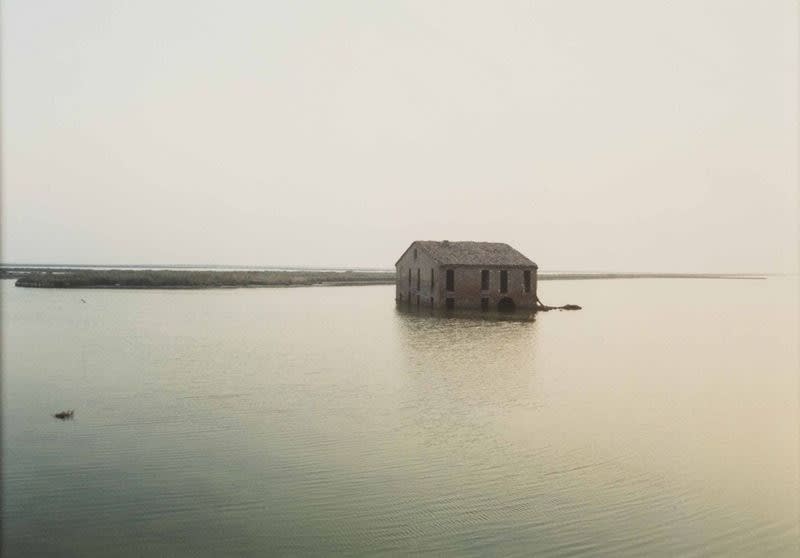
Luigi Ghirri (1943-1992), Comacchio
Argine Agosta From Il profilo delle nuvole, 1989 (printed 2004), Copyright © Cambi Casa d'Aste 2024. Lot 184
Luigi Ghirri's photographic work, particularly "Comacchio - Argine Agosta" and "Marina di Ravenna," has significantly impacted Giordani's approach to capturing the subtleties of everyday life. Ghirri, a master of capturing the poetic essence of ordinary scenes, often focused on the interplay between natural and man-made environments. His ability to transform mundane moments into profound visual narratives aligns with Giordani's philosophy. Her reference to the shower in Knokke illustrates her ability to find profound beauty and inspiration in mundane, overlooked details. This perspective aligns with Ghirri's philosophy of discovering new worlds in familiar surroundings, highlighting the poetic stillness and latent potential in daily life.
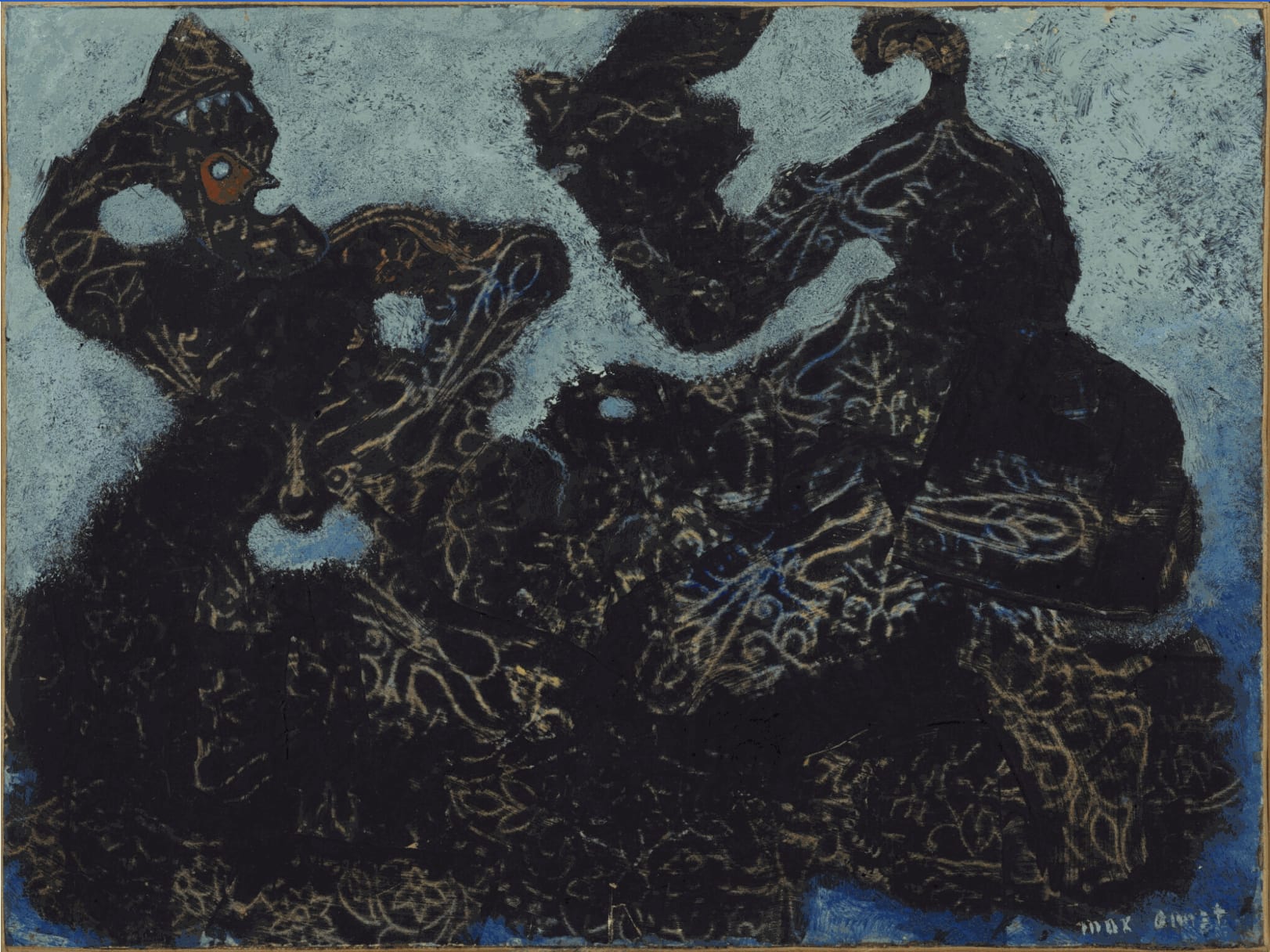
Max Ernst, Barbes, 1934
Barbares, 1935, signed, oil on paper laid on canvas, 23.5 x 31.8 cm (9.25 x 12.52 inches). © 2024 Sotheby's, 'Lot 34, from an artist collection.'
Max Ernst's "Barbares" and René Magritte's "Le Duo" further inform Giordani's exploration of surreal and ambiguous landscapes. Max Ernst, a pioneer of the Surrealist movement, is known for his innovative techniques and dreamlike imagery. His work "Barbares" exemplifies his ability to blend reality with fantasy, creating a sense of suspended reality that invites viewers to question the boundaries of the known and unknown. Similarly, René Magritte's "Le Duo" plays with materiality and perception, using ordinary objects in extraordinary contexts to challenge viewers' understanding of reality. Magritte's work often features enigmatic and thought-provoking compositions that resonate with Giordani's approach to creating mysterious and evocative environments.
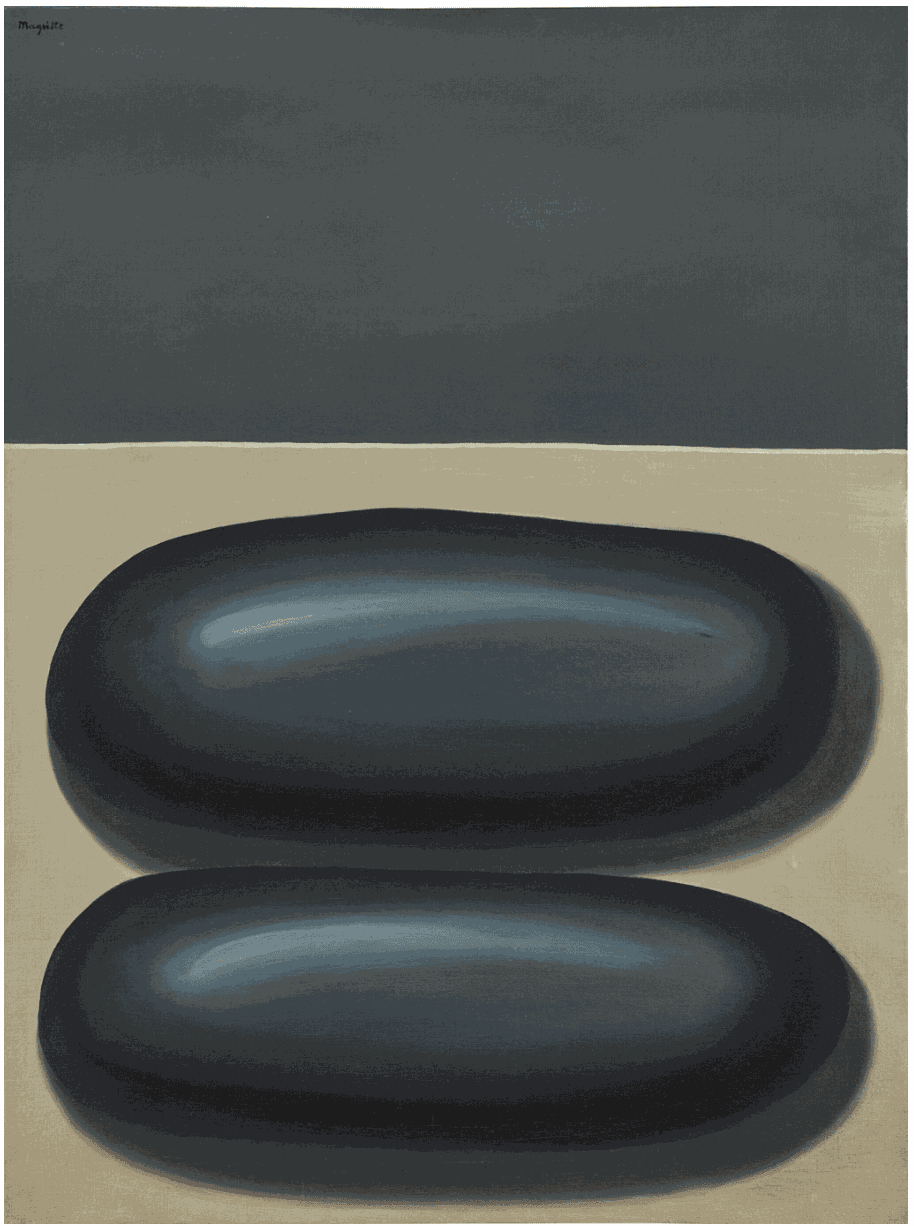
René Magritte, Le Duo, 1928,
Signed Magritte (upper left), titled "Le Duo" (on the lower turnover edge), oil on canvas, 28 ¾ by 21 ¼ in. (73 by 54 cm). © 2024 Sotheby's. Lot 139 - Pillars of Modernism: property from a private European Collection.
Giordani's paintings often embody a sense of suspended reality, inviting viewers to question the boundaries between the known and the unknown. Her ability to draw from such a diverse range of influences and incorporate them into her unique artistic vision makes her work a compelling exploration of the human condition and the mysteries of existence.
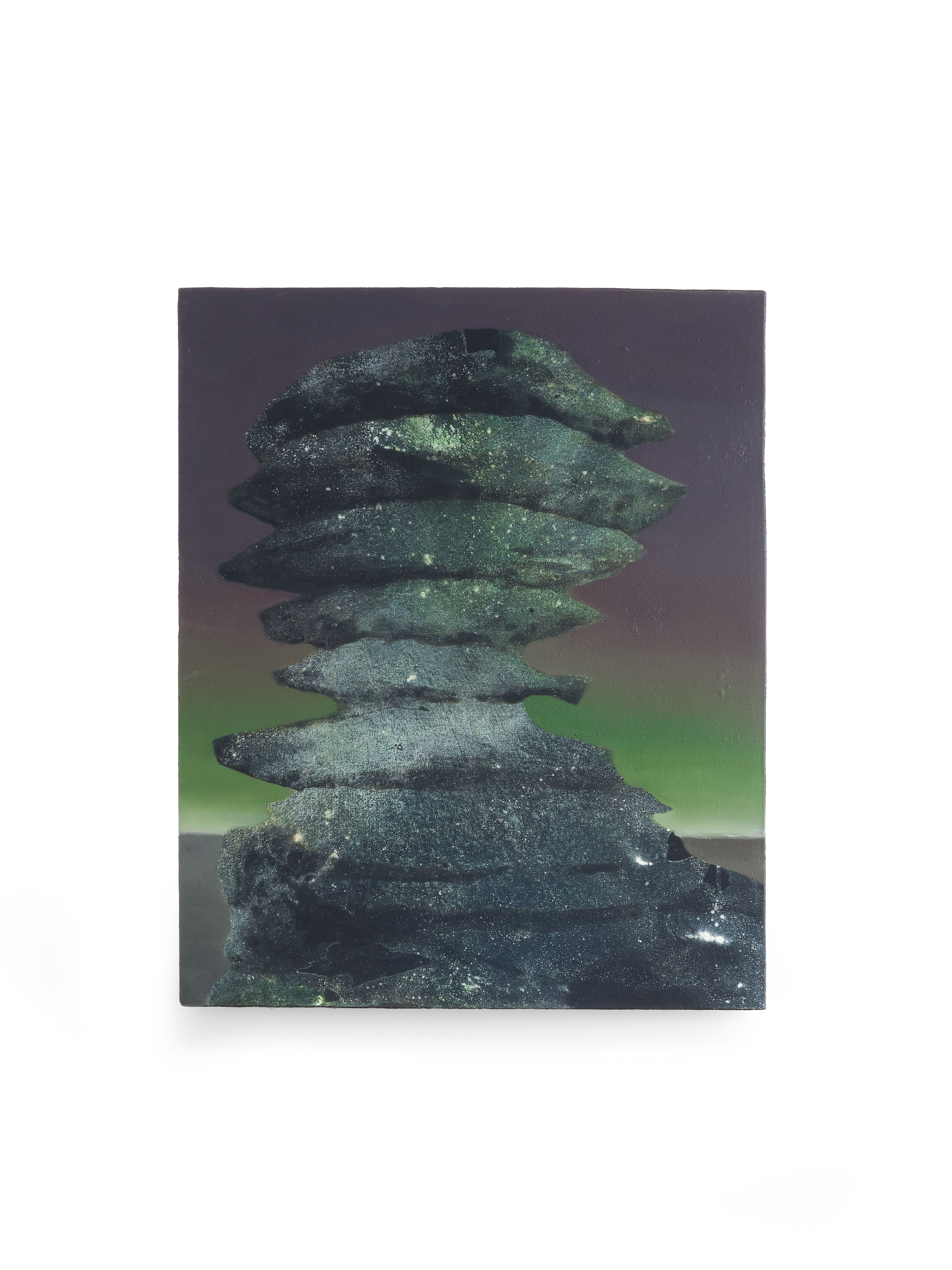
Silvia Giordani, Moondust, 2023, Acrylic and oil on canvas, 21 5/8 x 17 3/4 in 55 x 45 cm
"Moondust" and Monolithic Architecture
Giordani's recent work, "Moondust," epitomizes her thematic focus on the symbolism of the moon and monolithic structures. Created before the exhibition title was decided, "Moondust" features materials reminiscent of lunar dust, evoking a sense of otherworldliness and scientific exploration. The green light in the painting suggests a radioactive or alien landscape, further blurring the lines between the familiar and the fantastical.
Her fascination with monolithic architecture, inspired by prehistoric dolmens, is evident in her use of stone as a central element. These stones, whether depicted as ancient totems or futuristic artifacts, symbolize the passage of time and the enduring presence of the natural world amidst human intervention. Prehistoric dolmens, with their monumental stone structures, represent a connection to the ancient past, while also evoking a sense of mystery and timelessness. Giordani's incorporation of these elements in her work underscores her exploration of the intersections between history, mythology, and the future.


